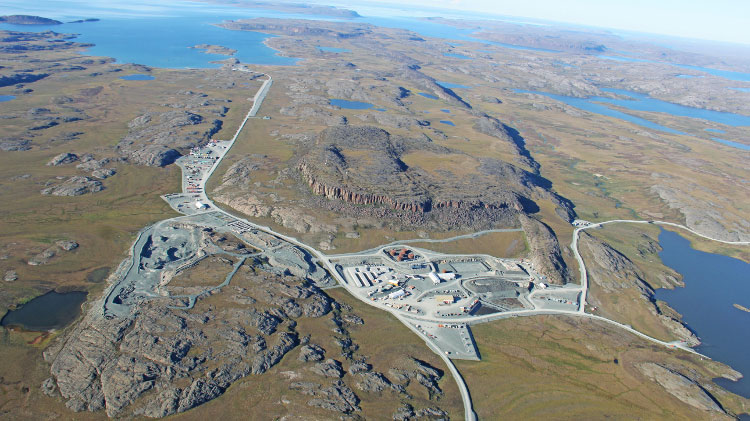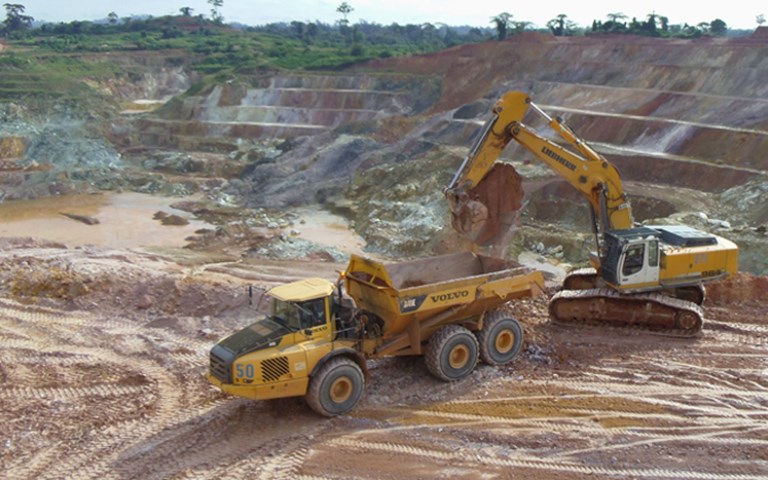SMI’s project will eventually involve five open pits. Courtesy of Société des Mines d’Ity
Since SNC-Lavalin won Société des Mines d’Ity’s (SMI’s) bid for a prefeasibility study on the Ity mine expansion and optimization in 2013, the project has developed into a real open pit engineering puzzle. The Montreal-based company, which is presently working on the feasibility study, has been juggling a number of challenges ranging from environmental management to dewatering, slope stability, varied geology of multiple pits and seasonal floods.
Since its commissioning in 1991, the Ity mine has consisted of a single pit and a heap leach facility. The expansion project includes the opening of four new pits, two of which are on the other side of the Cavally River. “In 2018 we will operate the new CIL (carbon-in-leach) plant, and we would then have five pits to feed it with, in addition to the heap leach residue, which we want to reprocess too,” said Nicolas Verdier, project manager at La Mancha, a privately held gold producer that owns 55 per cent of SMI.
One of the oldest operating large-scale gold mines in Côte d’Ivoire, the Ity mine, located near the border with Liberia on the western side of the Cavally River, has produced nearly a million ounces of gold in its two-decade history, but not much attention had been paid by former owner Areva to extending the life of the mine beyond 2017. Following La Mancha’s acquisition by Egyptian billionaire Naguib Sawiris for US$493 million in July 2012, an exploration and optimization strategy was put in place to give the Ity mine a second life.
Results from the exploration campaign significantly increased Ity’s resources and encouraged SMI to launch a prefeasibility study in late 2013 to determine whether to replace the heap leach facility with a CIL plant. According to the study, completed last December, the updated reserves for the whole project amount to one million ounces.
An intensive drilling campaign conducted by SMI in late 2014 and early 2015 is expected to bring significantly more resources to the project. SMI and La Mancha are now targeting around two million ounces in reserves by the end of this year, which would ensure an extended mine life of more than 10 years, starting in 2018.
Construction work is planned to start in 2016 to ensure continuity between the old heap-leach operations and the new CIL plant. Verdier said the recent drilling campaign and the ongoing development of the engineering make SMI and La Mancha confident in the development of the project.
The river runs through it
The project planners must contend with the Cavally River, which runs near two of the four newly planned pits: Walter and Daapleu. In addition to its proximity, the river is a challenge because it also tends to overflow its banks during the rainy season, requiring a wide floodplain. “We have no other choice than to build perimetre dykes to prevent the pits from being flooded,” said Luc-Bernard Denoncourt, project manager at SNC-Lavalin. “In the case of the Daapleu pit, we also need to build a diversion channel because the river runs exactly through it.”
The building of the diversion channel must be handled carefully. “We are carrying out a hydrological study to get a modelling of the river and determine what impacts the channel could have,” said Denoncourt. The Cavally River has a fairly significant flow, with many different fish species present. Communities downstream depend on the river for fisheries, and construction work at Ity could affect spawning grounds and banks. “Technically and socially, it is a challenge and we will manage it carefully,” said Verdier.
Another, related aspect is hydrogeology that could potentially put high water pressure on the pit slopes. “Since we are close to the river, the hydrogeological challenge is to reduce the water level to protect the slopes’ stability,” said Verdier. “We must pump enough water to reduce the water pressure on the slope. The challenge is to target the best location to optimize the dewatering cost.”
To mitigate this risk, SNC-Lavalin has undertaken a hydrogeological campaign and drilled a series of holes, and is now carrying out pumping tests at the Daapleu pit.
The third challenge related to water is the location of the tailings storage facility. The majority of the property is flat and, during the flood season, an average of two to three metres of water collects on the floodplain. “We can’t choose a flood-prone area, yet we can’t put it too far for transport cost reasons, and we must stay within property limits,” said Verdier.
In January 2014 a group of SNC-Lavalin geotechnical specialists went about selecting a location for the tailings facility. “We looked at the map, identified potential sites and proof-walked them to ensure we encountered no major physical obstacles,” Denoncourt explained. In the end, the tailings storage facility will be outside of the floodplain and surrounded by low hills, which minimize the cost of building a large dyke and mitigate potential environmental impacts. The selected area is located on the side of a hill, on the southwest side of SMI’s property.
Things get harder
SMI must also deal with two fundamentally different geological structures. Ity’s first pit was dug in soft laterites and oxidized, mineralized clays, extending from the surface to hundreds of metres deep. “This is a crumbly material, which we only need to crush a little, without grinding,” said Verdier.
However, the new pits in the eastern side of the property consist of granodiorites, meta-volcanized sediments and daaplites as hard as the Canadian Shield. These rocks will need much more intensive crushing and grinding.
Both soft and hard materials will go through the same processing circuit though, in proportions that will change in time depending on the grades of their different zones. “This will require flexibility in the processing plant,” said Verdier. “Sometimes we will process more soft material, sometimes more hard material.” These mixes must be planned beforehand, since they are going to impact the plant’s design. And with five different outputs, mining optimization at Ity needs to be done properly.
Finally, the project also entails displacing the village of Daapleu, which sits next to the future pit of the same name. Its 300 inhabitants, who depend on fisheries and agriculture, have outlined the conditions they expect to be met before they move including the location to which they would like to move. SMI’s relocation action plan for Daapleu is fully integrated into the ongoing environmental and social impact assessment studies.
Break it down to build it up
“Not all mines have many pits with a completely different geology,” said Denoncourt, reflecting on the uniqueness of this project. “Optimizing the mining sequence depending on various satellites is not common to all mines. Add to that the completely different geologies, and you end up with a very interesting project where pit optimization and mine scheduling is crucial for the project’s success.”
These challenges are not new to SNC-Lavalin when taken by themselves, however. “Each of these risks has being addressed individually,” said Denoncourt. “The challenge in every project is to identify risks and implement the optimal mitigation strategy. We managed to find low-cost alternatives to reduce each of them.”




